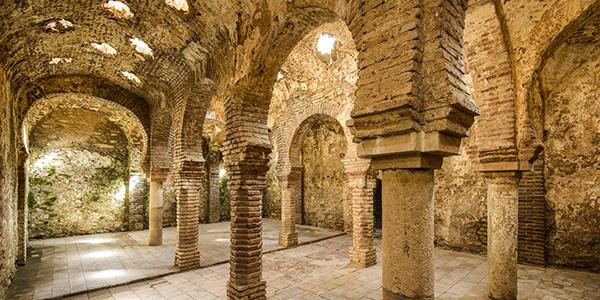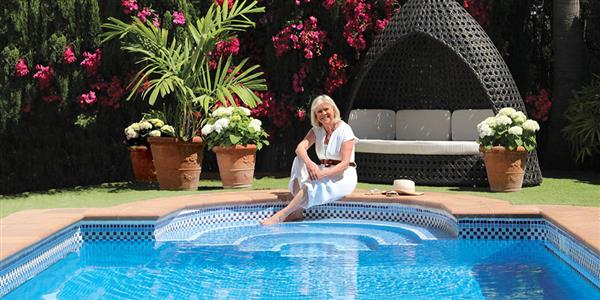
Ronda is one of Spain’s oldest cities. It is located in the south of the country, to the west of Malaga. Its origins can be traced back to Celtic settlers from the 6th century BCE, though it was later, during the Roman times that it really became established, from the 3rd century BCE onwards.
A visit to Ronda will walk you through thousands of years’ worth of history. There are prehistoric settlements dotted in the surrounding area and examples of Neolithic rock paintings in the Cueva de la Pileta, a tourist attraction about half an hour outside the city.
More information here.
Ronda has passed from hand to hand throughout history, becoming a part of the Roman Empire more than once and you can still see the remains of a Roman amphitheatre at Acinipo, about half an hour north of the city, which was believed to have been built by retired soldiers in the first century BCE, around the time of Julius Caesar.

The Romans moved on during the 6th century CE and by the 8th century Ronda was occupied by the Arabic people, who named it Hisn Ar-Rundah. The Islamic occupation of Ronda continued through to the 15th century and it was during this time that Ronda received much of its Islamic architectural heritage. As you explore the city, you’ll see traces of what they’ve left behind them.
The Ronda town walls were defensive structures that in parts date back to the 12th century. They don’t encircle the entire town, but instead are split into sections; due to its geological position perched atop an impenetrable canyon, the city was already protected from the west. The Walls of Cijara, at the east of the old town are double thickness and you’ll still find the large Puerta de la Cijara, doorway to the city.

The Walls of Cijara separate the town from the Arab Baths, Baños árabes, just outside the old town to the north east. These are all that are left of the former Jewish Quarter of Ronda. They are still in excellent condition, and really beautiful to see. The underground arches and chambers are really impressive and they are open to the public most days of the week.
Take a look at opening times and prices here.
The south walls are also impressive and house the Puerta de Almocabar which is the large entryway that would have lead visitors in from the south. You can walk along the old walls here in parts.

The city is famous for its three bridges; the Puente San Miguel, the Puente Viejo (Old Bridge), and the Puente Nuevo (New Bridge). Each was built to cross the deep gorge for which Ronda is known. The bridge of San Miguel is the oldest of the three and a single arch structure. The Puente Nuevo is the most impressive. First built in the 18th century, this stunning bridge spans the 120-metre deep drop into El Tajo gorge, carved over time by the Guadalevín River, and bisecting the city. The Puente Nuevo is located at the northern edge of the old town, connecting it to the modern quarter. It’s multi-tiered with one large arch at the bottom supporting the top three arches that span the canyon. At the very centre is a square room that now houses a museum though has, in the past, been a prison during the 19th and 20th centuries.

Ronda’s turbulent history continued after the Islamic occupation into the 15th century. The Catholic Monarchs' conquest of the ancient city in 1485 left its mark, which is evident in the altered structure of the town and streets; now broader and built on a grid design.
Following the Spanish Inquisition and the later Peninsular War in the early 1800s the surrounding area of Ronda became the base for a number of bandits. Over time the bandits of Ronda have become romanticised and is still a popular talking point today.
The landscape of the backdrop and the legends ghosting the surrounding mountains have fuelled a lasting interest in the 19th century's banditry, with their evocative names and escapades amongst the hills and caves. The Museo del Bandolero can be found right in the heart of Ronda’s old town and here you’ll discover some of the famous names and legends from the era. The museum introduces you to the history, and it houses a number of exhibitions with photography, videos and written information
Find opening times and prices here.
One final sight, while you’re in the city, is the Plaza de Toros de Ronda. This huge bullring was designed by the same architect that was responsible for the Puente Nuevo, José Martín de Aldehuela, who had also worked on the reconstruction of Málaga Cathedral a few years earlier. The bullring was built between 1779 and 1785. It’s well-known for its large inner arena which has a diameter of 66 meters. Around the outside are two rings of stone seating, each with five tiers and 136 elegant pillars.

Find out how to visit Ronda for yourself and to stay nearby in beautiful Bena Vista on the Costa del Sol. Enter your details at the bottom of the page for a free brochure.

